Ego
Time for the conclusion of serial experiments lain.
Layer 13: Ego begins with blue static and Lain saying she’s confused again. Well, so are we. Rather than a voice-over we start with a recap of the last part of Layer 12. Alice doesn’t handle it so well, and we’re then shown a screen with the message, “ALL RESET” and on a second line, “Return.” Rewind!
The next few scenes show us what the different characters are up to now, after Lain presumably fixed things by undoing everything Eiri had done. Everyone is living, well, not quite happily ever after, but better. Only a couple people seem to notice that Lain isn’t there. Lain, however, is not happy. She has a conversation with a double about omnipotence and omnipresence. When Lain gets fed up with that, the image of her father appears in the sky, and they have some tea in the clouds.
Now comforted, Lain meets a now adult Alice, and they have a short conversation. The blue static returns, one more time, and Lain says to the camera, “I promise you I’ll always be right here. I’ll always be right next to you, forever."
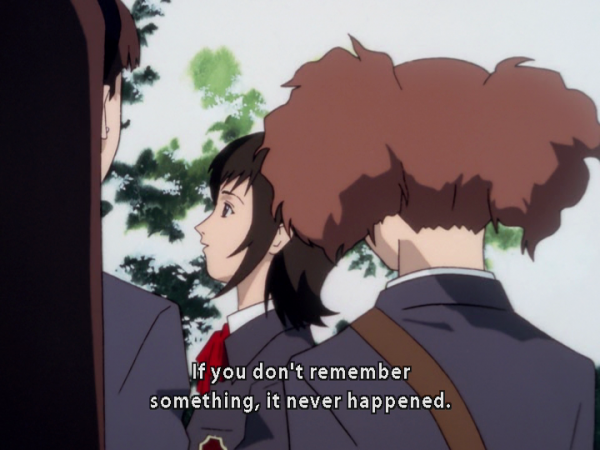
Well, we talked about what happened to Eiri in the last episode. The experience traumatised poor Alice, though, and this prompts Lain to fix everything. That she can do this tells us that she effectively is a goddess of the Wired, and that she’s destroyed the boundary between the Wired and the real world - at least for herself. She is the deity Eiri so desperately wanted to be.
There are a couple small but interesting points in the “reset” scenes. Everyone seems to be back in the same place they were before, except for the MIBs who are working on utility poles. I suppose Lain’s looking out for them by putting them in a much safer profession. Also, Alice apparently did reach out to a loner in this version of events just as she did before, but to Chisa instead of Lain. I imagine she’ll serve as a grounding influence for her just as she did for Lain. Oh, and we get one more shot of the greenery-surrounded utility pole.
Also, the only people who notice Lain’s absence at all are her father and Alice. How much Mr. Iwakura knows is ambiguous since he doesn’t actually say anything, so it may just be a vague feeling that someone is missing from the dinner table. As for Alice, her lines and body language tell me that she is aware of what Lain did. It takes her a moment to realise who Julie and Reika think she wants to invite to Cyberia, and after a moments of thought she says, “Oh, I get it…” She then tells them “It’s nothing,” but with an expression like she knows more than what she’s letting on. “If you don’t remember something, it never happened.” How much Alice remembers is impossible to say. Based on the very end of the episode she doesn’t remember Lain explicitly, but she certainly has some awareness of what happened.
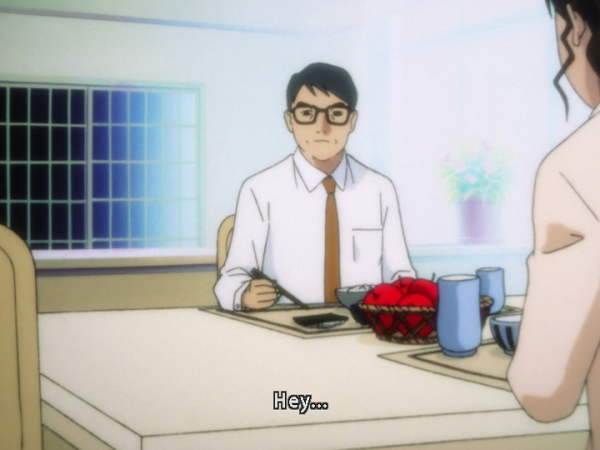
The “Present day, present time” guy and the cityscape coming in the middle of the episode is unexpected, but gives us the sense that the first half of Layer 13 is simply a continuation of Layer 12, while the second half is a new beginning. At this point the world is in order, but what about Lain herself?
We meet her in a deserted city, and a double asks why she isn’t happy - she’s deleted herself from everyone’s memory, but no one is being hurt and no one hates her. However, as most of us know (and as Alice could’ve said) we need real, meaningful relationships, connections, with other people to be happy. Freedom from pain isn’t enough, even if that freedom comes with divine power, which her double encourages her to embrace at the end of this conversation.
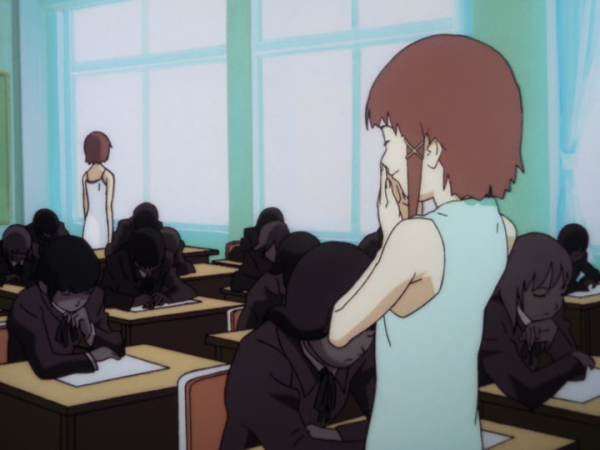
Lain’s double, by the way, is both helpful and a tease for the audience here. She gives us a relatively clear, brief explanation of what the Wired is, saying that “The Wired isn’t an upper layer to the real world.” Rather, it’s a network, which passes along information. Furthermore, “People’s memories aren’t just personal or one part of the history of humanity. No, not even the shared unconscious.” She adds that it’s connected to something else, but she doesn’t say what that is. From her explanation that humans couldn’t build something vast enough to contain so much information, it must be connected to a higher power of some kind, and the only mentions of such a higher power have been God, whose existence (in a traditional sense) doesn’t fit in with lain’s materialistic view of the world; Lain herself, who’s resistant to seeing herself as a goddess and who herself seems to have been created by something else; and the alien.
If it’s the last, that would imply that our short-statured friend’s appearance was, in fact, literal, not metaphorical and not a mere instance of the collective unconscious. Unfortunately, as far as I can tell lain doesn’t give us enough clues for a definite answer. I’m unable to even venture a theory beyond this alien and the power that Lain’s double refers to is some kind of higher being, but have little idea what sort of being this might be.
So, this brings us to another of lain’s best scenes, where Lain dons the bear pyjamas for one more conversation with her father. I like how Mr. Iwakura essentially points out the thematic meaning of her pyjamas, and his reference to madeleines refers to Marcel Proust’s famous novel In Search of Lost Time, though unfortunately I’ve read very little of that book, so I don’t know the full significance of this. Regardless, the main point here is that he helps Lain understand why she’s sad, despite fixing the world’s problems (or at least those caused by Eiri and friends) - love. Pretty simple in a way, but the need for human connection is one of lain’s major themes.
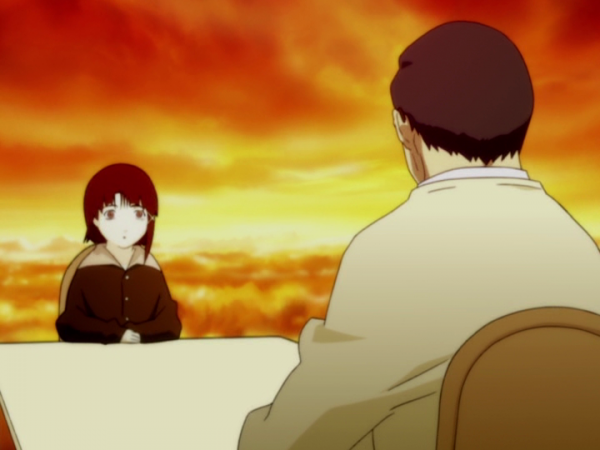
There are a couple questions about this scene: where is Lain, and why does she see this vision of her father? The “where” is, as usual, either the Wired or a purely subjective point of view. The “who” is more difficult. Mr. Iwakura in the real world appears to be a normal person now, so it’s not literally him. Furthermore, no one besides Lain and, perhaps, our alien buddies, can project images like this now. So, I’d venture that he’s a projection created by Lain herself, working through her feelings with an essentially imagined conversation with the person most likely to be able to guide and comfort her from her previous life.
Regarding the last full scene, I’ve always thought that Alice’s boyfriend is the teacher from earlier, and thought maybe Lain had made her older or him younger so they could be together, but I’m not completely sure. Right after the reset Alice was the same age as always. Either way, there’s little to add to this scene except that it’s appropriate to end with the real heroine of this story.
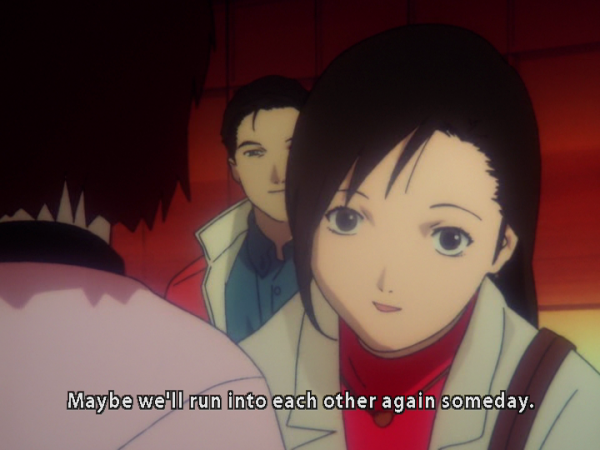
The final scene has an encouraging message from our new deity, and so it ends.
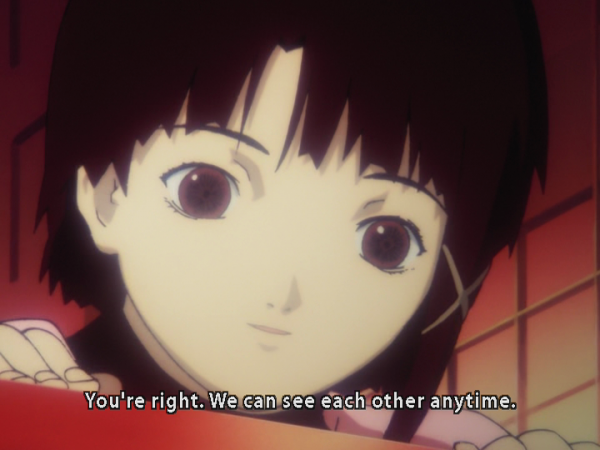
So, here we are, at the very end. Now that we’ve gone through every episode individually, let’s take a few moments to take a step back and look at _serial experiments lain _as a whole by asking a few questions.
First, I enjoy the show a lot, obviously, but aside from my own nostalgia is lain a good anime? I’ll say yes, it is. The music and artwork are all great, though the animation could be more fluid. I’ve pointed out some of the best individual shots as we’ve gone along, but there are many more and someone with more experience talking about film and the visual arts generally could find a good deal more to say about the show’s visual techniques, as well as its aesthetic. The characters are all developed well enough for thirteen episodes, and everything moves along at a slow but steady pace.
The main objections, I think, will be to the rather obscure plot. I’ll freely admit that it’s not a show everyone will enjoy because so much is kept deliberately vague, but I think I’ve shown that if you watch carefully, especially in multiple viewings, there’s enough here to piece together a coherent story. I’d like things to be a little clearer, but then again, it just wouldn’t be lain anymore without a lot of mystery.
Second, is _lain _at the level of what we might call high art? This is a difficult one because it’s rather vague, but the issue of hierarchies among the arts is one I enjoy thinking about. As I said in that linked post, the most reliable test to see if something is really a classic is how well it stands the test of time. Lain is certainly an anime classic, and one that’s found some audience even among people who don’t watch a lot of animation. Ultimately, its fate will likely be tied closely to how well animation fares as a whole. If animators continue to develop this young medium and audiences continue to appreciate it, I think it will fare well.
Still, as for my own opinion, lain is certainly ambitious and attempts to address big issues about men and technology, and does so with some success. It doesn’t reach the level of the classics of literature, the Iliads and Hamlets of the world, but it deserves to be taken seriously and does reach the level of the second tier of literature.
Finally, does lain actually mean anything? That is, does it succeed in its attempt to address its themes? The results, I think, are mixed. There’s a lot of name-dropping and some philosophising, but the characters doing the philosophising often aren’t reliable and the infodumps on, say, Ted Nelson and the rest, though interesting, are there primarily to serve the plot. Of course, there’s not really enough time in a thirteen episode anime to go into depth on big questions the way, say, Dante does in the Divine Comedy, so I don’t hold that against it. Lain is worth watching in part because it raises some interesting questions; it doesn’t provide answers.
All in all, then, these serial experiments have been a resounding success. Serial experiments lain still has a large and loyal fan base after twenty years - an eternity in popular culture. Lain connected with many of us, not only when it was released but at this point with fans who weren’t even into anime at the time, possibly not even born yet at the time.
Animation is a spectacular, fascinating medium, and lain is among the best it has to offer. Thank you all for reading, and I hope that, like me, you’ve found some new appreciation for lain along the way.
